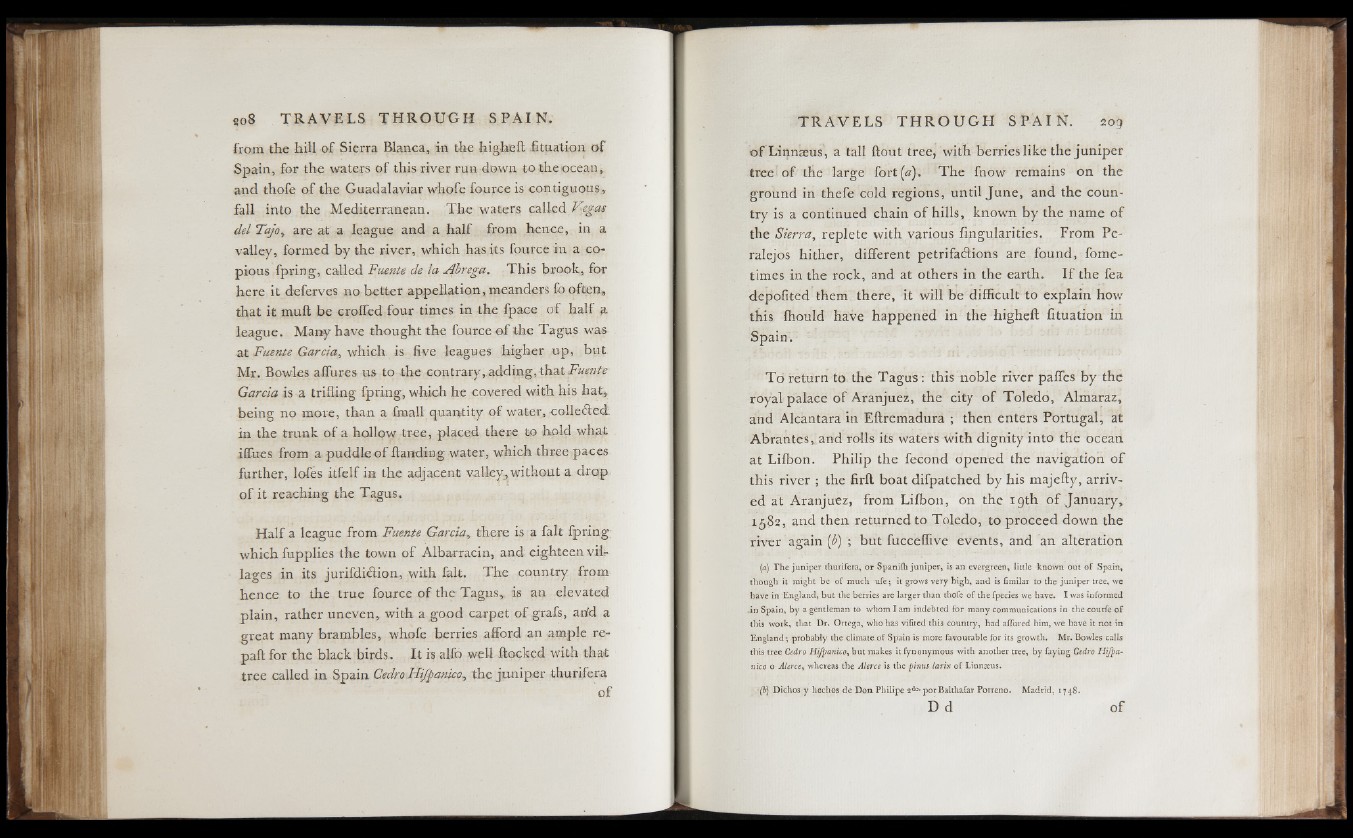
from the hill of Sierra Blanca, in the higheft fituation of
Spain, for the waters of this river run down to the ocean,
and thofe of the Guadalaviar whofe fource is contiguous,
fall into the Mediterranean. The waters called Vlegas
del Tajoy are at a league and a half from hence, in a
valley, formed by the river, which has its fource in a copious
fpring, called Fuente de la Airega. This brook, for
here it deferves no better appellation, meanders fo often,
that it rauft be crofted four times in the fpace of half a
league. Many have thought the fource o f the Tagus was
at Fuente Garcia, which is five leagues higher up, but
Mr. Bowles afiures us to the contrary, adding, that Fuente
Garcia is a trifling fpring, which he covered with his hat,
being no more, than a final! quantity of water, collecled
in the trunk of a hollow tree, placed there to hold what
iffues from a puddle o f Handing water, which three paces
further, lofes itfelf in the adjacent valley, without a drop
o f it reaching the Tagus.
Half a league from Fuente Garcia, there is a fait fpring:
which fupplies the town of Albarracin, and eighteen villages
in its jurifdiCfion, with fait. The country from
hence to the true fource o f the Tagus, is an elevated
plain, rather uneven, with a good carpet of grafs, arid a
great many brambles, whofe berries afford an ample re-
paft for the black birds. It is alfo well flocked with that
tree called in Spain Gedro Hifpanico, the juniper thurifera
of
o f Linnaeus , a tall flout tree, with berries like the juniper
tree of the large fort (a). The fnow remains on the
ground in thefe cold regions, until June, and the country
is a continued chain o f hills, known by the name of
the Sierra, replete with various Angularities. From Pe-
ralejos hither, different petrifactions are found, fome-
times in the rock, and at others in the earth. I f the fea
depofited them there, it will be difficult to explain how
this ihould have happened in the higheft fituation in
Spain.
To return to the Tagus: this noble river paffes by the
royal palace of Aranjuez, the city of Toledo, Almaraz,
and Alcantara in Eftremadura ; then enters Portugal, at
Abrantes, and rolls its waters with dignity into the ocean
at Liibon. Philip the fecond opened the navigation o f
this river ; the firft boat difpatched by his majefty, arrived
at Aranjuez, from Liibon, on the 19th of January,
1582, and then returned to Toledo, to proceed down the
river again (¿) ; but fucceffive events, and an alteration
(a) The juniper thurifera, or Spaniih juniper, is an evergreen, little known out o f Spain,
though it might be o f much u fe ; it grows very high, and is Gmilar to the juniper tree, wc
have in England, but the berries are larger than thofe o f the fpecies we have. I was informed
.in Spain, b y a gentleman to whom I am indebted for many communications in the courfe o f
this work, that Dr. Ortega, who has viGted this country, had allured him, we have it not in
England^ probably the climate o f Spain is more favourable for its growth. Mr. Bowles calls
this tree Gedro Hifpanico, but makes it fynonymous with another tree, b y faying Gedro Hifpanico
o Alercty whereas the Alerce is the pinus larix o f Linnjeus.
;(2») Dichos y hechos de D on Philipe 2do* porBalthafar Porreno. Madrid, 1748.
D d o f